
Table of Contents
Ever wondered how your voice could reach millions, spark conversations, and even become a source of income? Welcome to the world of podcasting, where content creation meets audio marketing, and your ideas have the power to captivate audiences worldwide. But with over 2 million podcasts and counting, how do you ensure your voice stands out in the crowd? This article, ‘Starting a Podcast: From Idea to Launch in 10 Steps’, is your comprehensive guide, taking you on a journey from the spark of an idea to the thrill of your first podcast launch.
Agree with us when we say that starting a podcast can seem daunting, especially with the plethora of technical terms and equipment options. But what if we promised to simplify this process, breaking it down into manageable, actionable steps? By the end of this article, you’ll not only understand the podcast landscape but also have a clear roadmap to launch your own show. Let’s dive in!
First, consider this: according to a 2021 survey by Edison Research, 75% of Americans are now familiar with podcasting, with 55% having listened to a podcast in the past. This means there’s a vast, eager audience waiting for your unique perspective. But with great opportunity comes great responsibility
- to create compelling content that resonates with your listeners. So, the question is, what’s your story, and how can you tell it in a way that captivates?
In this article, we’ll explore the art of content creation, helping you find your niche and develop a unique voice. We’ll delve into the technical aspects, from choosing the right equipment to editing your audio like a pro. We’ll also guide you through the world of audio marketing, helping you build an audience and monetize your podcast. So, are you ready to turn your idea into a reality and join the ranks of successful podcasters? Let’s get started!
Mastering Content Creation and Audio Marketing for Your Podcast Launch
Embarking on a podcasting journey is an exhilarating adventure, and mastering content creation and audio marketing are the twin compasses guiding your vessel to success. Imagine your podcast as a vibrant, ever-evolving city, with each episode a new district, brimming with unique stories and insights. Content creation is the city planner, meticulously designing each episode’s architecture, ensuring it’s engaging, informative, and true to your podcast’s unique identity. It’s about crafting compelling narratives, inviting guests who bring fresh perspectives, and balancing depth with accessibility. Audio marketing, on the other hand, is the city’s PR department, shouting your podcast’s praises from the rooftops. It’s about understanding your audience, optimizing your SEO for discoverability, and leveraging social media to build a loyal community. Think of it as a symphony, where content creation is the melody, and audio marketing is the harmony, creating a captivating, unforgettable podcast experience. So, let’s roll up our sleeves, dive into the details, and turn your podcast into a bustling metropolis that’s impossible to ignore.

Conceptualize Your Podcast
Embarking on the podcasting journey is an exciting adventure, and the first step is to conceptualize your podcast with crystal clarity. Let’s dive into the essential aspects that will shape your podcast’s identity and ensure it resonates with your audience.
The first order of business is to define your podcast’s niche. This is the unique space you’ll occupy in the vast podcasting landscape. It could be a specific topic, a particular angle on a broader subject, or a blend of themes that appeal to your interests and passions. For instance, if you’re into true crime, your niche could be unsolved mysteries, or you might focus on the psychological aspects of criminal behavior.
Next, it’s crucial to identify your target audience. Who are the people most likely to tune in to your podcast? Are they professionals seeking industry insights, students looking for educational content, or perhaps enthusiasts who share your passion? Understanding your audience will help you tailor your content to their needs and preferences, making your podcast more engaging and valuable to them.
Once you’ve nailed down your niche and audience, it’s time to decide on your podcast’s format. Will you be solo, co-hosted, or interviewing guests? Will each episode be a standalone story or part of a series? The format you choose should complement your content and enhance the listening experience. For example, a storytelling podcast might benefit from a narrative structure, while a panel discussion could work best with a roundtable format.
Now, let’s talk about your podcast’s unique value proposition. What makes your podcast stand out from the crowd? Is it your unique perspective, your engaging storytelling style, or perhaps your ability to delve deep into topics that others overlook? Whatever it is, communicating this value clearly will help attract and retain listeners.
To brainstorm your podcast idea, start by jotting down all the topics, formats, and features that appeal to you. Don’t worry about filtering at this stage; the goal is to generate as many ideas as possible. Once you have a list, look for patterns or connections between the ideas. This could help you refine your concept or even combine multiple ideas into a single, cohesive podcast.
Validating your podcast idea is equally important. This could involve conducting market research, surveying potential listeners, or even creating a pilot episode to gauge interest. Here are some steps to help you validate your idea:
- Research your niche to ensure there’s an audience for your topic and that it’s not already saturated.
- Identify your competition and find out what works and what doesn’t in your niche.
- Create a landing page or social media profiles for your podcast to start building an audience and gather feedback.
- Record a pilot episode and share it with a small focus group to get their feedback.
By following these steps and taking the time to conceptualize your podcast, you’ll be well on your way to creating a show that resonates with your audience and stands out in the crowded podcasting landscape.
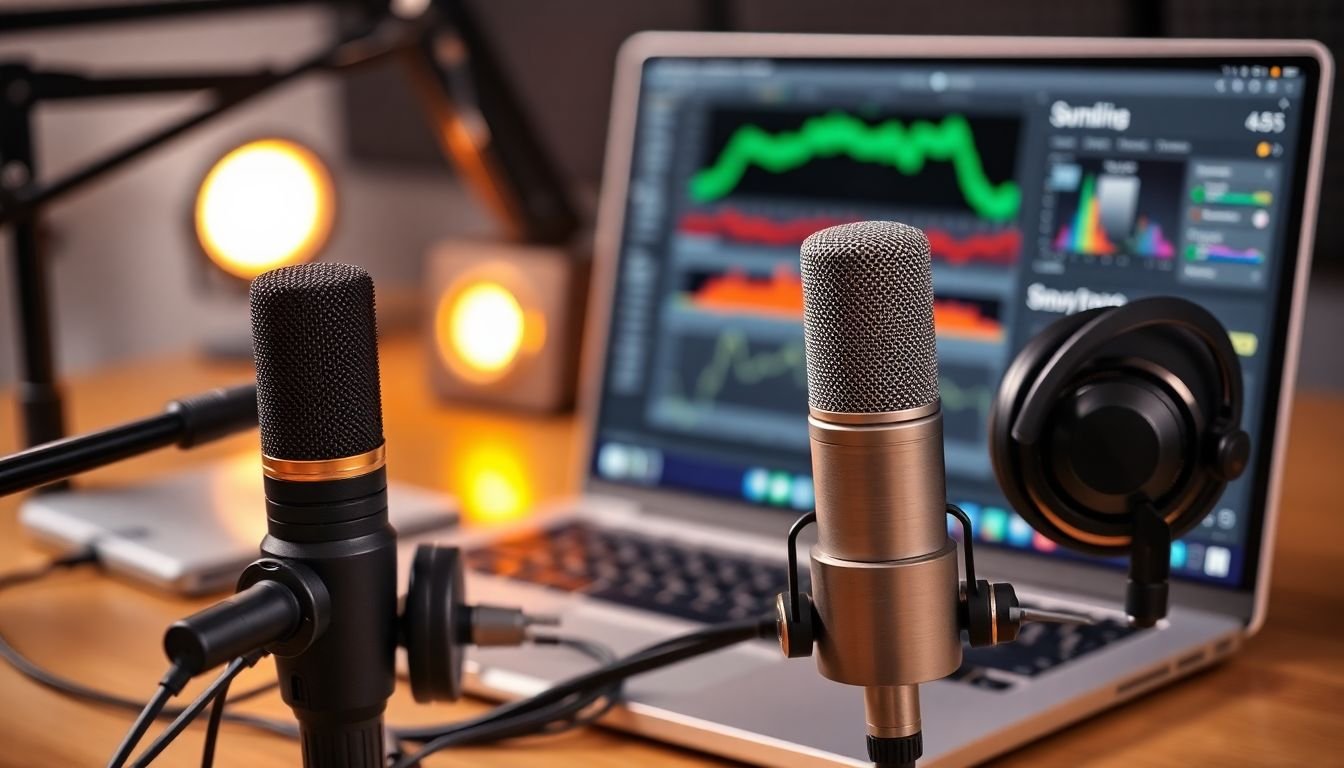
Invest in Essential Equipment
Embarking on a podcasting journey is an exciting venture, and investing in the right equipment is key to ensuring your audio quality stands out. Let’s dive into the essential equipment you’ll need to start your podcast, keeping both quality and budget in mind.
The heart of any podcast setup is a reliable microphone. For beginners, USB microphones are a great starting point due to their ease of use and affordability. The Audio-Technica ATR2100x-USB and Samson Q2U are popular choices, offering excellent sound quality for their price. If you’re looking to step up your game, consider dynamic microphones like the Shure SM58, which requires an audio interface but delivers professional-grade sound.
Next, let’s talk about headphones. While any pair will do, investing in a good quality set can greatly enhance your listening experience. The Sony MDR-7506 and Audio-Technica ATH-M50x are both budget-friendly options that offer great sound isolation and clarity. They’re perfect for monitoring your audio and editing your podcast.
Recording software is another crucial aspect of podcasting. Audacity is a free, open-source option that’s user-friendly and packed with features. It’s an excellent choice for beginners. If you’re willing to invest a bit more, Adobe Audition offers a more robust set of tools for editing and enhancing your audio. Both options allow you to record, edit, and mix your podcast episodes with ease.
Remember, the key to a successful podcast is clear, engaging audio. Don’t skimp on your equipment, but don’t break the bank either. There are plenty of budget-friendly options that can help you achieve professional-quality sound. So, go ahead, invest in these essentials, and let your voice shine!
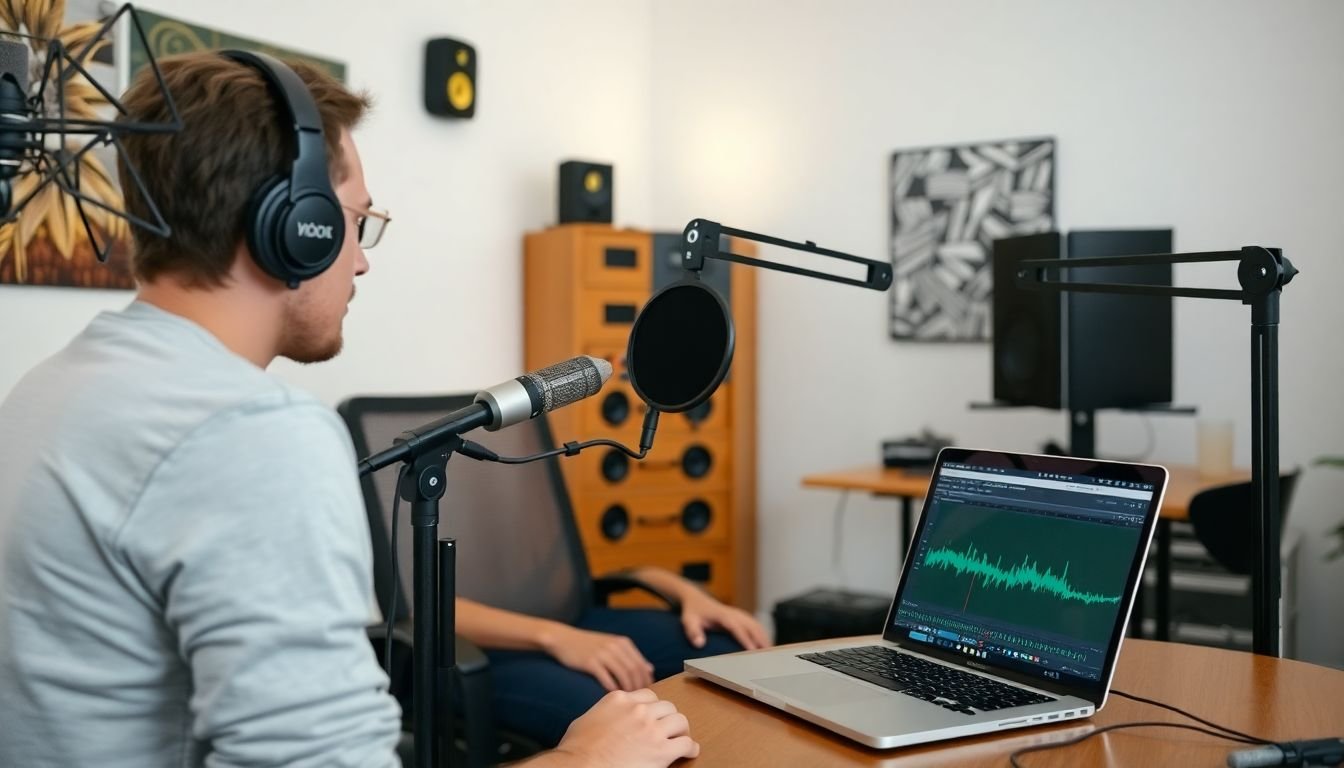
Master Recording and Editing Techniques
Welcome, aspiring podcasters, to the fascinating world of mastering recording and editing techniques! Let’s embark on this sonic journey, transforming your raw audio into a polished, engaging listening experience. First, let’s set the stage for your podcast’s debut with a well-prepared recording space.
Your recording space, or ‘studio,’ doesn’t need to be a soundproof fortress. A simple, quiet room will do. To minimize echo, consider adding some soft furnishings like blankets, pillows, or even a bookshelf. Position your microphone away from walls and windows to avoid picking up unwanted noise.
Now, let’s talk microphones. Invest in a quality USB microphone, like the Blue Yeti or Audio-Technica ATR2100, for crystal-clear audio. Position it about 6-8 inches away from your mouth, ensuring your voice is the star of the show.
Recording solo? No problem! But if you’re inviting guests, consider using a separate microphone for each speaker. This allows for better control during editing and ensures everyone sounds their best. Use headphones to monitor audio and avoid feedback.
Once you’ve captured your audio gold, it’s time to edit. Begin by listening to your entire recording, making notes of any sections you’d like to enhance or remove. Use your editing software’s ‘cut’ and ‘copy’ functions to trim silences, remove ‘ums’ and ‘ahs,’ and create a smooth, engaging flow.
To enhance your podcast’s sound, consider these basic editing techniques:
- Normalize your audio to ensure consistent volume levels.
- Use compression to reduce the dynamic range, making quiet parts louder and loud parts quieter.
- Apply noise reduction to minimize background noise.
- Add EQ (equalization) to boost or cut specific frequencies, improving your voice’s clarity.
- Start with a blank calendar, either digital or physical, and mark out your planned publishing dates.
- Brainstorm episode ideas and jot them down in a separate list. These could be topics, guests, or story angles.
- Match your episode ideas with the publishing dates on your calendar. Be sure to mix and match formats to keep things interesting.
- Leave some blank spaces for spontaneous or timely content. After all, life is full of surprises, and your podcast should be ready to pounce on them.
- Hi [Name],
- I’m a big fan of [mention their work].
- I host a podcast called [your podcast name] and I think your perspective would be a great fit for our audience.
- I’d love to invite you for an interview/collaboration. Here are the details:
-
- Format: [interview/collaboration]
- Duration: [duration]
- When: [date and time]
- Looking forward to hearing from you!
- Best,
- [Your Name]
When it comes to creating engaging interviews or collaborations, preparation is key. Research your guest’s work, prepare thoughtful questions, and leave room for organic conversation. Here are some tips:
- Ask open-ended questions to encourage storytelling and detailed responses.
- Prepare for follow-up questions based on their answers.
- If it’s a collaboration, discuss the format beforehand. It could be a joint interview, a panel discussion, or a creative exchange.
- Promote the episode on your social media platforms and website to generate interest and engagement.
Remember, every guest brings a unique energy to your podcast. Embrace this, and you’ll create compelling content that your listeners will love.
- Assess your podcast’s needs and budget
- Compare features, such as analytics, storage, and ease of use
- Read reviews and ask for recommendations from fellow podcasters
- Take advantage of free trials to test the platform before committing
- Know Your Brand: Before you start designing, understand your podcast’s brand. What’s its personality? What makes it unique? Your artwork should reflect these qualities.
- Keep It Simple: Complex designs can get lost in small sizes. Opt for clean, simple layouts that can be understood at a glance.
- Use High-Quality Images: Invest in good quality images. They’re the backbone of your artwork. Stock photo websites like Unsplash, Pexels, or Shutterstock offer a wealth of options.
- Consistency is Key: Maintain a consistent style across all your episode artwork. This helps build brand recognition.
- Text Matters: Include your podcast’s name and episode title. Use clear, easy-to-read fonts.
- Use relevant keywords in your podcast’s title and description. Make sure they accurately represent your podcast’s content.
- Write detailed show notes for each episode, incorporating relevant keywords and providing a summary of the episode’s content.
- Optimize your episode titles with relevant keywords. This can help improve your podcast’s visibility in search results.
- Encourage listeners to leave reviews and ratings. Positive reviews can boost your podcast’s visibility on these platforms.
- Consistency is key. Regularly publish new episodes and maintain a consistent podcasting schedule.
- Choose an RSS feed generator or use one provided by your hosting platform.
- Input your podcast’s details: title, description, cover art, and episodes.
- Copy the generated RSS feed URL.
- Submit your feed to directories like Apple Podcasts, Spotify, and Google Podcasts, following their specific submission guidelines.
- Consistently release new episodes on a schedule.
- Guest interviews can bring new listeners and boost your reach.
- Collaborate with other podcasters for cross-promotion.
- Engage with your audience through Q&As, polls, or shout-outs in your episodes.
- Leverage social media platforms, email newsletters, and your website to promote new episodes.
- Monitor your podcast’s performance using analytics to understand what’s working and what’s not.
- Collect and Organize: Gather feedback from various sources and organize it in a way that’s easy to analyze.
- Identify Trends: Look for common themes or trends in the feedback. These could be compliments, criticisms, or suggestions.
- Prioritize: Not all feedback is equally important. Prioritize the feedback that’s most relevant to your goals and audience.
- Act: Use the insights from the feedback to make changes to your podcast. This could be anything from adjusting your format to inviting different guests.
- Iterate: Podcasting is a continuous process. Regularly review your analytics and feedback, and use them to make ongoing improvements to your podcast.
- Keep it simple, catchy, and easy to remember.
- Include keywords related to your topic to improve search visibility.
- Avoid using numbers or special characters, as they can make it harder to find on podcast directories.
- Test it out by saying it aloud and imagine hearing it as a listener. Does it roll off the tongue or feel clunky?
- A decent quality USB microphone. Popular choices include the Audio-Technica ATR2100x-USB or the Samson Q2U.
- Headphones to monitor your audio and listen to guests.
- Recording and editing software. Audacity is a free, user-friendly option, while Adobe Audition is a more advanced choice.
- A computer or laptop to run your software and record your episodes.
- Introduction (0:00 – 0:30): Hook listeners with an interesting fact, question, or joke. Introduce your topic and any guests.
- Content (0:30 – 30:00 – 60:00): This is the meat of your episode. Break it down into segments or sections to keep listeners engaged.
- Outro (30:00 – 0:60): Summarize your key points, thank your listeners, and tease your next episode. Include a call-to-action, encouraging listeners to subscribe, rate, or share your podcast.
- Storytelling: People connect with stories. Incorporate storytelling into your episodes to make them more relatable and memorable.
- Interviews: Invite guests with unique perspectives to interview. This not only provides fresh content but also exposes your podcast to their audience.
- Series or arcs: Plan your episodes in series or arcs, focusing on a specific topic over several episodes. This helps build anticipation and keeps listeners engaged.
- Engage with your audience: Respond to listener feedback, questions, or comments. This can inspire episode topics and makes your listeners feel valued.
- Zoom: Zoom offers a free plan that allows you to record interviews up to 40 minutes long. It’s easy to use and has good audio quality.
- Skype: Skype is another popular choice, but audio quality can vary. Use the ‘Record’ feature to capture your conversation.
- Cleanfeed: Cleanfeed is a web-based platform designed specifically for podcast interviews. It offers high-quality audio and easy recording features.
- Before your interview, test your equipment and internet connection. Communicate with your guest about the recording process to ensure a smooth interview.
- Remove awkward silences, umms, and ahhs. Be mindful not to over-edit and lose the natural flow of conversation.
- Use music and sound effects sparingly to enhance your content, not distract from it. Ensure you have the rights to use any music or sounds.
- Normalize your audio levels to ensure consistent volume throughout your episode. Most editing software has a normalization tool.
- Listen to your episode with headphones in a quiet environment to catch any audio issues you might have missed.
- Hosting: Choose a podcast hosting platform like Libsyn, Podbean, or Buzzsprout. They store your audio files and provide an RSS feed for directories.
- Directories: Submit your RSS feed to podcast directories like Apple Podcasts, Spotify, and Google Podcasts. This makes your podcast discoverable to a wider audience.
- Cover art: Design eye-catching cover art that represents your podcast’s theme and catches the listener’s eye.
- Show notes: Write detailed show notes for each episode, including a summary, key takeaways, and any relevant links. This improves SEO and provides value to your listeners.
- Social media: Share your episodes on platforms where your target audience is active. Engage with your followers and share behind-the-scenes content.
- Guest blogging: Write guest posts for blogs in your niche. Include a link to your podcast in your author bio.
- Collaboration: Partner with other podcasters or influencers in your niche for interviews or cross-promotion.
- Email marketing: Build an email list and send regular newsletters with updates, episode links, and exclusive content.
- Downloads/listens: The number of times your episodes have been downloaded or played.
- New subscribers: The number of new listeners who subscribe to your podcast.
- Average duration: The average length of time listeners spend listening to your episodes.
- Listener demographics: Information about your audience, such as their location, age, and device type.
- Ratings and reviews: Listener feedback on platforms like Apple Podcasts. These can provide valuable insights and help improve your podcast’s visibility.
- Remember, less is often more in podcast editing. A light touch can make a world of difference. Happy editing!
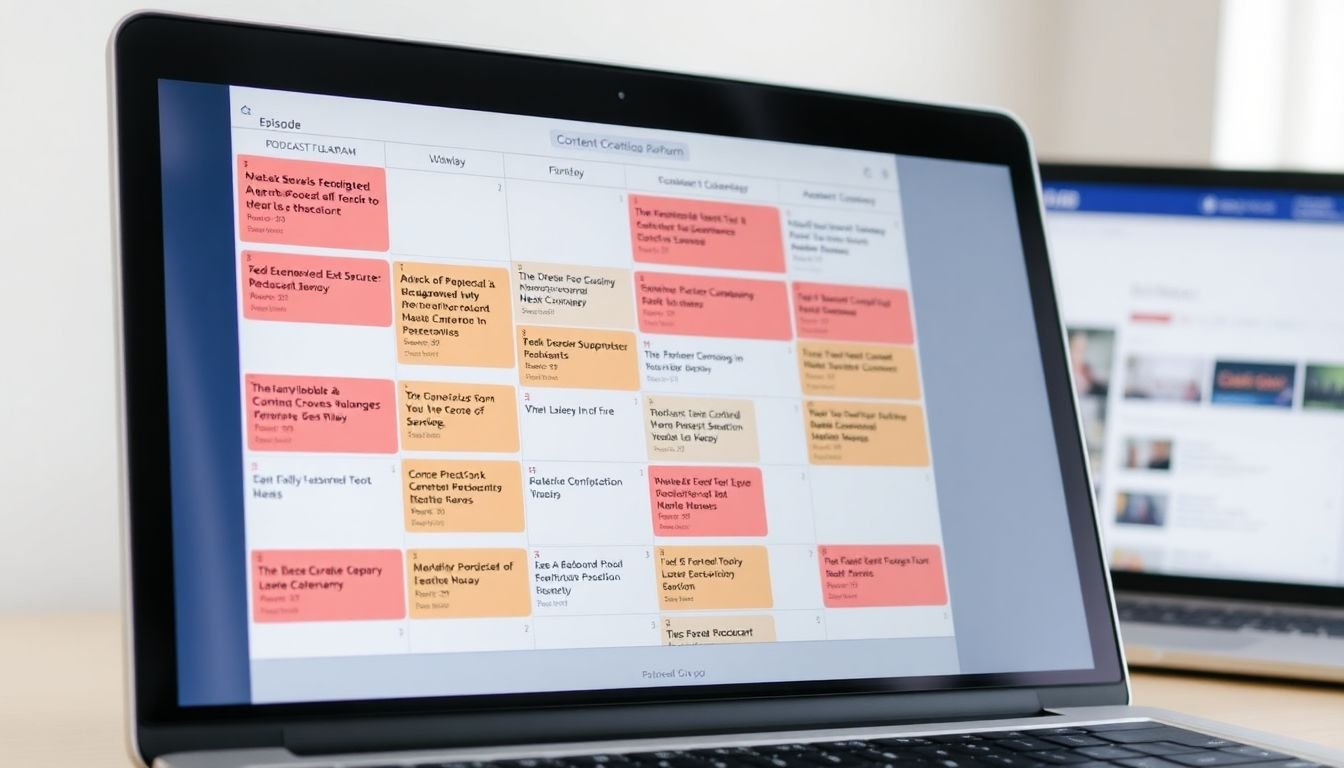
Plan Your Content Strategy
Planning your podcast episodes is akin to navigating a grand voyage, where each episode is a port of call, and your content strategy is the map guiding your journey. A well-planned podcast ensures consistency, engagement, and growth, making it an essential compass for your audio adventure.
First, let’s consider the importance of episode formats. Variety is the spice of life, and in podcasting, it’s the key to keeping your audience engaged. Different formats can cater to various listener preferences, from interviews and solo shows to panel discussions and storytelling. Experiment with formats to keep your content fresh and exciting.
Scheduling is another crucial aspect of your podcast planning. Consistency is key here. Whether you’re a weekly, bi-weekly, or monthly podcaster, maintaining a regular schedule helps build anticipation and loyalty among your listeners. It also helps you stay disciplined and focused on your content creation.
Now, let’s talk about creating a content calendar. This is your master plan, your roadmap to podcasting success. Here’s how you can create one:
Lastly, maintaining a backlog of ideas is like having a secret stash of treasure. When you’re feeling uninspired or short on time, you can dip into your backlog and pull out a gem. To keep your backlog stocked, set aside time each week to brainstorm new ideas. You never know when that spark of inspiration will strike!
So, grab your planning tools, and let’s set sail on this podcasting adventure. With a well-planned content strategy, you’ll navigate the audio waves with confidence and style.
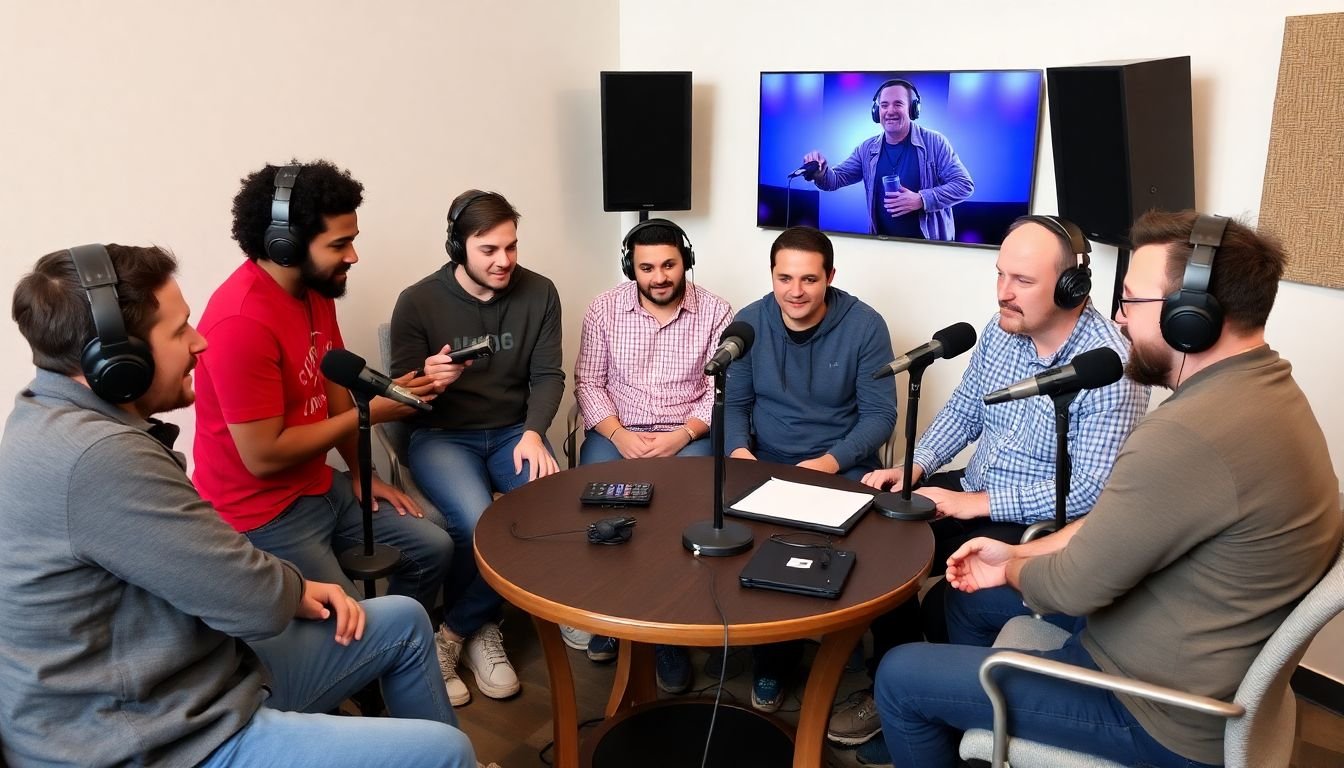
Invite Guests and Collaborate
Inviting guests and collaborating with other podcasters can breathe new life into your show, bringing fresh perspectives and engaging conversations to your listeners. This practice not only enriches your content but also expands your network and reach. Here’s how you can explore these benefits and create captivating interviews or collaborations.
First, identify potential guests who align with your podcast’s theme or could offer unique insights. They could be experts in your field, influencers, or even fellow podcasters. Once you have a list, it’s time to reach out.
Start by personalizing your invitation. Mention why you admire their work and how their presence could add value to your podcast. Be clear about the format, duration, and any other details they might need to know. Here’s a simple template:
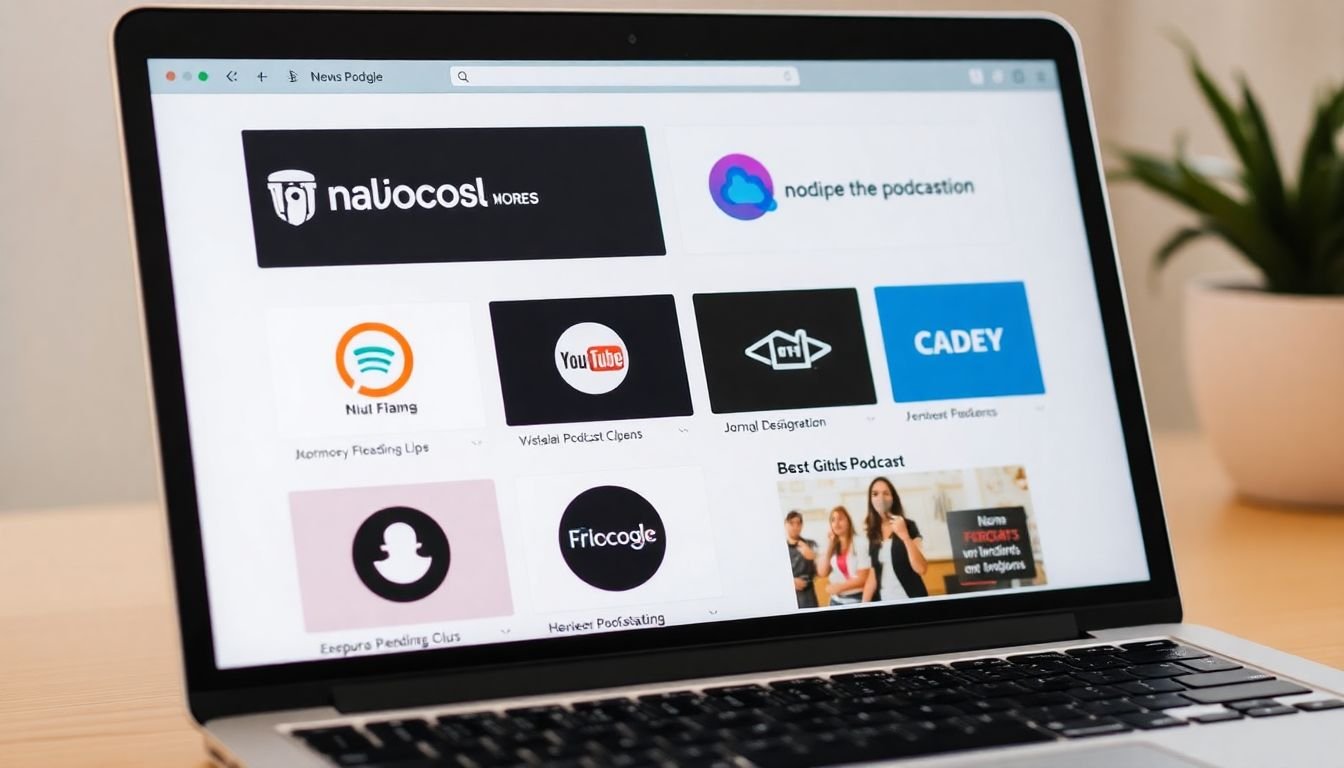
Choose a Podcast Hosting Platform
When it comes to choosing a podcast hosting platform, you’re spoiled for choice. Each platform offers a unique blend of features, pricing, and ease of use. Let’s dive into some popular options to help you make an informed decision.
First, consider your podcast’s specific needs. Are you looking for extensive analytics, unlimited storage, or perhaps a platform that’s easy on the wallet?
Libsyn is a veteran in the podcasting scene, offering robust analytics and a user-friendly interface. It’s a great choice for beginners, with plans starting at $5 per month. However, it does have a limited storage policy, so you’ll need to upgrade if you plan on uploading large files or multiple episodes.
Buzzsprout, on the other hand, offers unlimited storage for all its plans. It’s known for its clean, intuitive interface and excellent customer support. Their advanced statistics and promotion tools are a plus, with plans starting at $12 per month.
Podbean is another popular choice, offering unlimited hosting with their unlimited audio plan for $9 per month. It’s known for its ease of use and built-in features like a website builder and custom apps. Plus, it has a unique ‘Pay What You Want’ option for those on a tight budget.
Anchor is a free platform owned by Spotify, making it an attractive option for those just starting out. It offers unlimited hosting, easy recording tools, and distribution to major podcast platforms. However, it lacks some advanced features and has a less intuitive interface compared to other platforms.
To choose the best platform for your podcast, consider the following steps:
Happy podcasting!
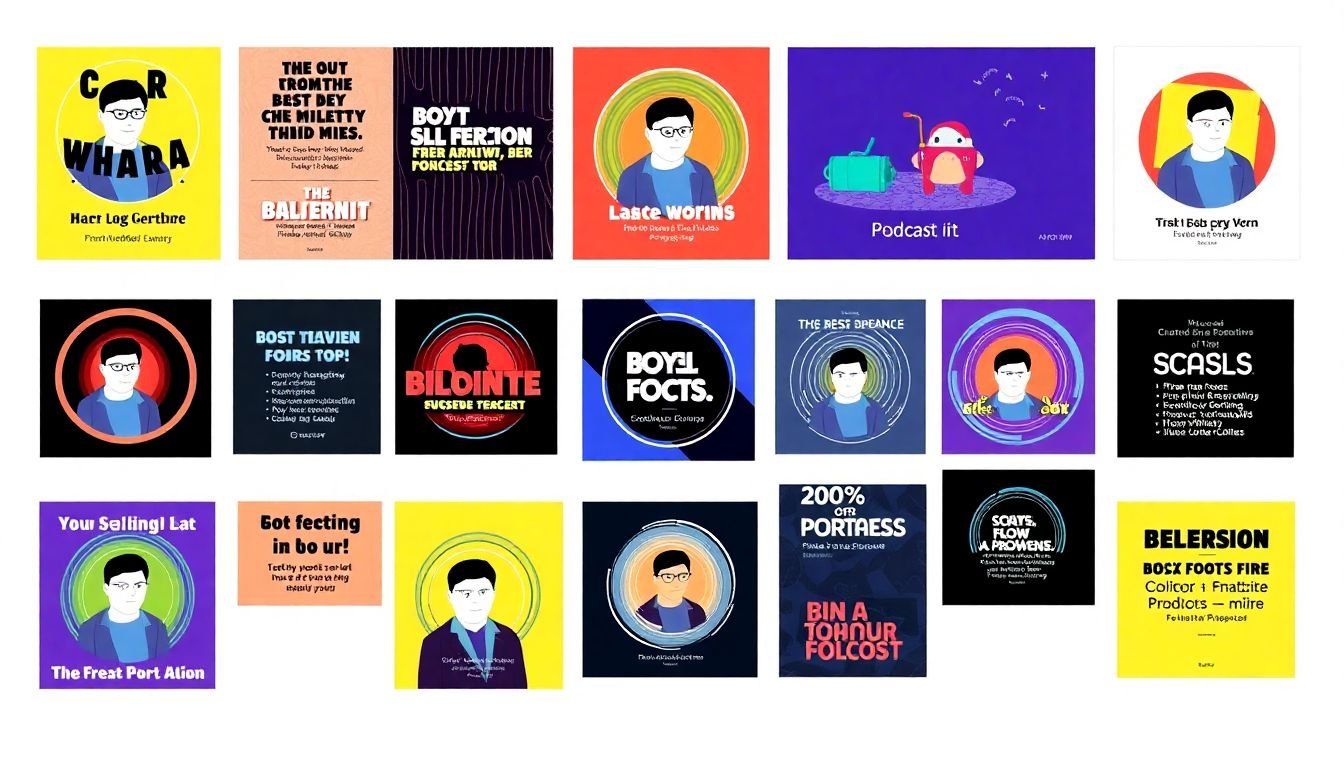
Design Eye-Catching Episode Artwork
In the vast landscape of podcasting, first impressions often make the difference between a potential listener hitting play or scrolling on. Episode artwork, that tiny thumbnail on podcast platforms, is your silent salesperson, enticing passersby with a glimpse into your audio world. It’s not just about looking good; it’s about communicating your podcast’s essence in a single, striking image.
Crafting eye-catching episode artwork is a blend of art and storytelling. It should align with your podcast’s brand, evoking emotions and curiosity that resonate with your target audience. Here are some tips to help you create visually appealing designs, even without graphic design experience:
As for tools, there are plenty designed for non-designers. Canva and Adobe Spark are user-friendly platforms with drag-and-drop interfaces and a wealth of templates. They also offer free versions with basic features. For more advanced features, consider Adobe Illustrator or Procreate, but these have a steeper learning curve. Online resources like YouTube tutorials and blogs can guide you through the design process. Don’t be afraid to experiment and have fun with it. After all, your artwork is a visual representation of your passion project!
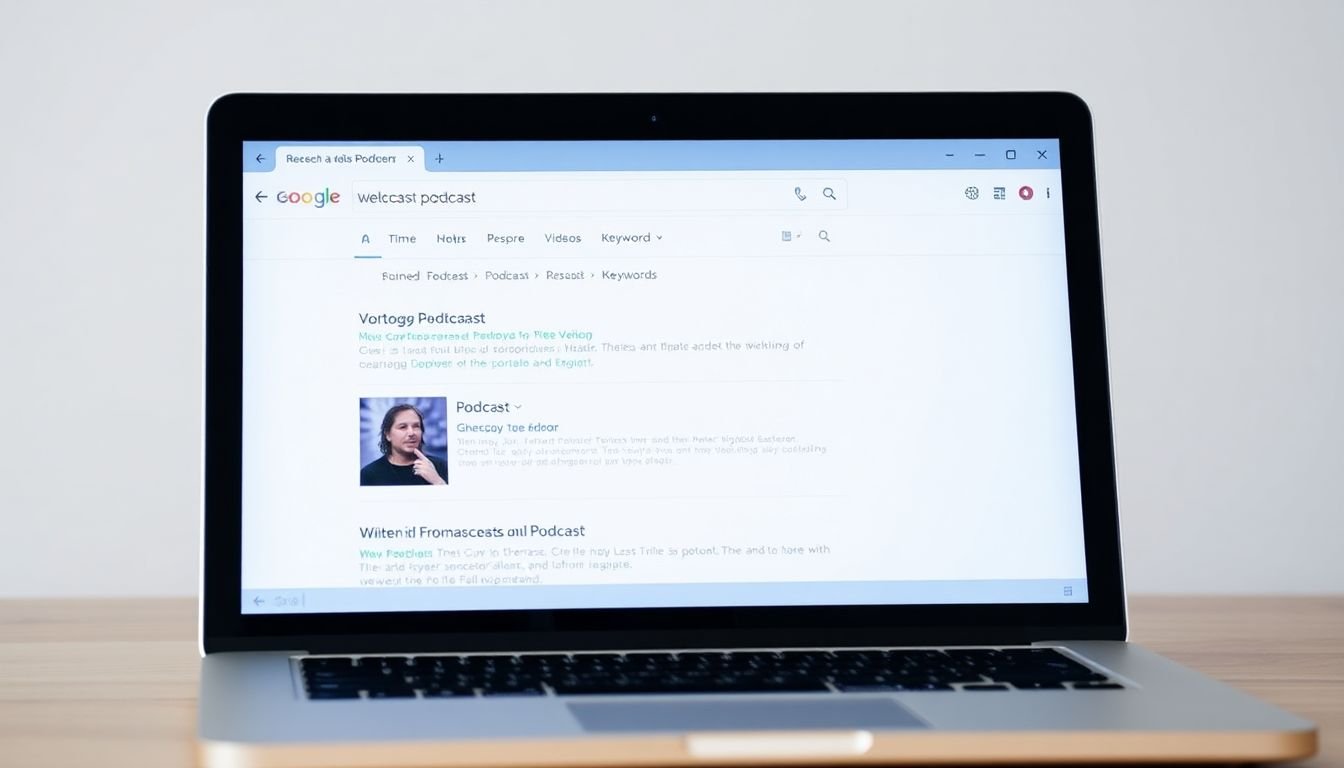
Optimize for SEO and Discoverability
In the vast, ever-expanding landscape of podcasts, standing out and being discovered by your target audience is no small feat. This is where the art of Search Engine Optimization (SEO) comes into play, transforming your podcast into a beacon that shines brightly in the search results of platforms like Apple Podcasts and Spotify. SEO for podcasts is not just about keywords and descriptions, but also about understanding your audience and providing them with valuable content that they can easily find.
Keyword research is the backbone of SEO. It’s about understanding what your audience is searching for and incorporating those terms into your podcast’s metadata. This includes your podcast’s title, description, and episode titles. For instance, if your podcast is about sustainable living, incorporating keywords like ‘eco-friendly’, ‘zero waste’, and ‘sustainable lifestyle’ can make your podcast more visible to those searching for such topics.
Show notes and episode descriptions are your podcast’s way of communicating with search engines. They provide context about your episode’s content, helping search engines understand what your podcast is about and who it’s for. Detailed, keyword-rich show notes can significantly improve your podcast’s discoverability. For example, if you’ve had a guest on your show, mentioning their name and their area of expertise in the show notes can help attract listeners who are interested in that topic.
Here are some steps to make your podcast more discoverable on platforms like Apple Podcasts and Spotify:
Remember, SEO is not a one-time task. It’s an ongoing process that requires continuous effort and adaptation. By optimizing your podcast for SEO, you’re not just making it more discoverable, but also providing a better listening experience for your audience. So, go ahead, let your podcast shine in the search results, and watch your listener base grow!

Launch and Promote Your Podcast
Embarking on a podcasting journey? Let’s dive into a step-by-step guide to launch and promote your podcast, turning your voice into a captivating medium that reaches the world.
First, record and edit your pilot episode, ensuring it’s polished and engaging. Then, it’s time to make your podcast discoverable. Platforms like Apple Podcasts, Spotify, and Google Podcasts are crucial for this. To submit your RSS feed, follow these steps:
Next, announce your podcast’s launch on social media. Create eye-catching graphics, write compelling descriptions, and use relevant hashtags to attract listeners. Engage with your audience by responding to comments and messages.
Once launched, keep the momentum going with ongoing promotion and growth strategies. Here are some tactics:
Remember, growth takes time, so stay patient, persistent, and passionate about your podcast. Happy broadcasting!
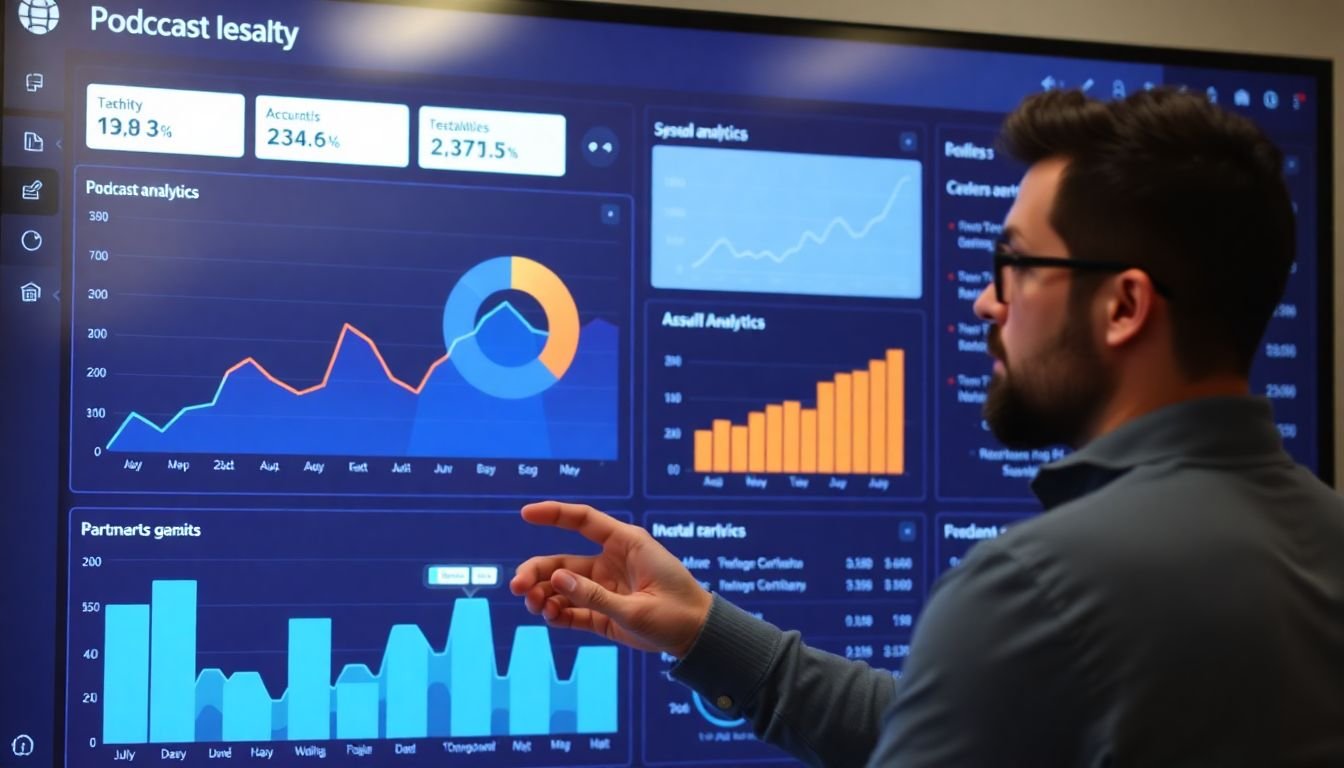
Measure Success and Iterate
In the dynamic world of podcasting, understanding your audience and the impact of your content is not just beneficial, but crucial for growth and improvement. This is where tracking podcast analytics comes into play. By monitoring key metrics such as downloads, listener demographics, and listener behavior, you gain valuable insights into what’s working and what’s not. This data-driven approach allows you to make informed decisions, ensuring that you’re allocating your time and resources effectively.
For instance, knowing which episodes have the highest download rates can help you understand what topics resonate most with your audience. Similarly, understanding listener demographics can help you tailor your content to better suit their interests and needs. Moreover, tracking listener behavior, such as skip rates and rewind points, can provide insights into the pacing and structure of your episodes.
However, analytics alone are not enough. Listener feedback is another powerful tool for understanding your audience and improving your podcast. This can be gathered through various means, such as post-episode surveys, social media engagement, or listener reviews. Feedback provides a human touch to the data, offering insights into why listeners enjoy certain episodes or aspects of your podcast, and where they feel improvements could be made.
To effectively use this feedback, consider the following steps:
FAQ
What is the first step in starting a podcast?
How do I choose a name for my podcast?
What equipment do I need to start a podcast?
You can always upgrade your equipment as your podcast grows.
How should I structure my podcast episodes?
Experiment with different formats to find what works best for you and your audience.